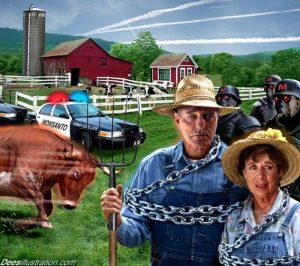Written by: Chuck Jolley – Cattle Network
She belts one out on Monday. Except ‘she’ will be a couple of he’s – Brooks and Dunn singing ‘That ain’t no way to go.’
The heavily promoted comment period for the U.S.D.A.’s National Animal Identification System (N.A.I.S.) listening tour will end on Monday. According to the U.S.D.A., comments received on or before this date will be considered. Hopefully written comments received after the final Omaha meeting will be taken more seriously than spoken comments were during the ‘live,’ face-to-face meetings.
“While the roundtables and public listening sessions are complete, I encourage those of you who still would like to share your concerns and suggestions about N.A.I.S. to submit your written comments by August 3,” said Ag Secretary Tom Vilsack, “We look forward to considering all the feedback before deciding on the future direction of U.S.D.A.’s traceability efforts.”
U.S.D.A. has posted a feedback page on the N.A.I.S. Web site. Whether you’re your for it or against it, go to www.usda.gov/nais/feedback now to provide your suggestions and comments.
If Vilsack is counting noses, N.A.I.S. will be deep-sixed on August 4. He announced the listening tour on May 15 as a way to find common ground for the development of the always controversial program. To be painfully blunt, common ground never existed. Only a pitifully small handful of people stood up for a national program during the 14 city tour. The vast majority of the often overly enthusiastic crowd spoke against N.A.I.S. using very specific and occasionally salty language. Trying to talk those people into accepting an animal identification program will be tougher than talking a card-carrying N.R.A. member out of his gun.
In fact, more than a few N.R.A. card-carrying farmers have promised to show anyone representing NAIS who dares step foot on his or her property a personal collection of fire arms. Barrel end first.
As a voluntary program, N.A.I.S. might have worked but only with the strongest possible assurances from the U.S.D.A. that ‘voluntary’ isn’t code for ‘mandatory’ within a few short years. Even that approach would be a hard sell as most of the speakers were outspoken about their innate distrust of anything that smacked of “Hello, I’m from the government and I’m here to help you.”
These are people who are used to doing it themselves. If any help is needed, it’s neighbor-to-neighbor, not federales to farmers. The mistake the USDA made was trying to organize this program from the top down. Going after the cooperation of state ag agencies and trade associations, they assumed, would win the day and the big boys did fall in line, lured by the promise of an ever expanding foreign trade opportunity. NAIS, though, is a bottom up program. It can only succeed with the consent and cooperation of the hundreds of thousands of small farmers from Portland, ME to Portland OR.
They said no.
If there is any confusion about the meaning of that word, maybe the U.S.D.A. can understand it a little better by clicking here.

 Mr. Hentges is a 1992 graduate of the University of Texas with a juris doctorate from the School of Law and a Master of Public Affairs from the Lyndon B. Johnson School of Public Affairs. He is a 1987 graduate of Oklahoma State University with a bachelor of science in agricultural economics.
Mr. Hentges is a 1992 graduate of the University of Texas with a juris doctorate from the School of Law and a Master of Public Affairs from the Lyndon B. Johnson School of Public Affairs. He is a 1987 graduate of Oklahoma State University with a bachelor of science in agricultural economics. “The first thing they did when they got the authority to write rules … was to grant themselves the authority to conduct warrantless searches. Wisconsin is in the process of coercing farmers and backyard producers … into NAIS, and the accompanying Premises ID program, by threatening to withhold any of the licenses they control.” Paul Griepentrog
“The first thing they did when they got the authority to write rules … was to grant themselves the authority to conduct warrantless searches. Wisconsin is in the process of coercing farmers and backyard producers … into NAIS, and the accompanying Premises ID program, by threatening to withhold any of the licenses they control.” Paul Griepentrog Although there is a bill in Wisconsin which would restore voluntary participation I feel it is nothing more than an attempt at political redemption by the same people who passed the mandatory bill to begin with, in that they are fully aware that this bills will be sent to the House Ag committee and never see the light of day. This is merely political posturing…. The house, senate and government are all controlled by Democrats. This may be nothing more than a smoke screen while they make mandatory phase II which is the tagging and chipping, which can’t be done unless you have a Premises ID.
Although there is a bill in Wisconsin which would restore voluntary participation I feel it is nothing more than an attempt at political redemption by the same people who passed the mandatory bill to begin with, in that they are fully aware that this bills will be sent to the House Ag committee and never see the light of day. This is merely political posturing…. The house, senate and government are all controlled by Democrats. This may be nothing more than a smoke screen while they make mandatory phase II which is the tagging and chipping, which can’t be done unless you have a Premises ID. A decision by U.S. District Judge Rosemary Collyer, located in the Washington District of Criminals, throwing out a lawsuit brought by Farm to Consumer Legal Defense Fund (FCLDF)
A decision by U.S. District Judge Rosemary Collyer, located in the Washington District of Criminals, throwing out a lawsuit brought by Farm to Consumer Legal Defense Fund (FCLDF) 


